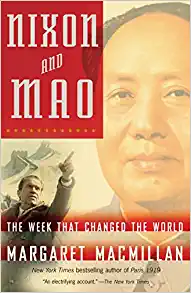Fifty years ago this week, on February 21, 1972, Air Force One touched down at Beijing’s Capitol Airport. President Richard Nixon, his wife, and a rather large entourage of officials were onboard. That this visit was momentous is an understatement as it marked the beginning of a thaw in the relationship between the two superpowers. This thaw would not only change the relationship between the US and China, but it would change the world.
Strangely, it is an event I remember well. I was a seventh grader at Karachi American School in Pakistan. I had already developed a keen interest in what we then called “current events.” Growing up in that part of the world in the 1960s meant that there were plenty of current events that we experienced first-hand. In fact, just a few months earlier we had experienced a war between Pakistan and India that necessitated an evacuation to the safe place in the region—Teheran, Iran. We had only recently returned.
Our teachers worked hard to instill in our merry band of expat kids the importance of knowing what was going on in the world and trying to understand the contexts. It didn’t hurt that many of the students were children of diplomats. In social studies class we would read LIFE magazine and the International Herald Tribune, paying particularly close attention to things happening in Pakistan.
In February of 1972, we had a field trip to the American Consulate to watch news reels of Nixon visiting in China. Back then we still called it Red China. As a Communist country it was, for all practical purposes, a forbidden country; yet here was the US President being greeted by Chinese leaders on Chinese soil. Of course, I never imagined that I would spend most of my adult life there.
Our interest in this story was also partly due to the fact that Pakistan had played an important role in the story. During the 1960s, when China was isolated from most of the world, Pakistan was a friend. China had a large consulate in Karachi which we would drive past every day going to and from school. I remember vividly the giant portrait of Mao hanging on the side of the building. There were also regularly scheduled flights between Pakistan’s capital in the northern part of the country and Beijing.
A lesser known chapter in the story of Nixon in China is that of National Security Advisor Henry Kissinger’s secret trip to Beijing in July 1971 to lay the groundwork for a possible visit by Nixon. As part of a public tour of Asia, he stopped in Pakistan for a few days, an event that our class was following intently. Once in Pakistan, he got sick and disappeared for a few days. We had no reason to doubt the report that he had a case of “Delhi Belly” (or as we called it “Karachi Tummy”) because every visitor we knew had the same experience upon visiting the country. It was a part of life. What we didn’t know until later was that it was all a ruse. He had snuck out of his hotel and boarded a flight to Beijing to meet with China’s leaders.
Shortly after Kissinger’s return to the US, President Nixon told the world about the secret trip and announced that he would be making a trip to China to meet Chairman Mao in February of 1972.
The rest, as they say, is history.
It can be argued that the thaw in US-China relations laid the groundwork for China’s opening and reform policies that were instituted by Deng Xiaoping later in the decade. China began to open to the outside world, allowing for travel and trade. The two sides issued the Shanghai Communique, which pledged to work towards normalization of relations.
Internal reforms led to growth of a market economy and the gradual relaxation of strict controls over all aspects of life which eventually saw the return of religious life (albeit it slowly) to society. This set the stage for explosive church growth and a more tolerant environment.
As the poet and hymn writer William Cowper puts it so well, “God moves in a mysterious way.” Today, as the relationship between the two nations takes a more troubled turn, that is a good reminder for us today.
To learn more about Nixon’s trip to China, here is a roundup of some interesting articles:
The Trip That Changed the World: Commemorating Kissinger’s 1971 Secret Visit to China (National Committee on US-China Relations)
On July 8, 2021, The Chinese People’s Institute of Foreign Affairs (CPIFA), with assistance from the National Committee on U.S.-China Relations, organized a multi-part event to commemorate the 50th anniversary of Dr. Henry Kissinger’s secret trip to China. The event took place at Beijing’s Diaoyutai State Guest House and featured live remarks by Dr. Kissinger and Vice President Wang Qishan. This video is an abridged version of the commemorative event.
Interview: ‘It began with a secret trip by Kissinger and myself’ (Radio Free Asia)
Former Ambassador Winston Lord on the 1972 Nixon-Mao meeting, Xi Jinping, and the Russia-Ukraine crisis.
Richard Nixon Announces He Will Visit China, July 15, 1971 (USC US-China Institute)
The President explained that National Security Adviser Henry Kissinger had been meeting with Chinese Premier Zhou Enlai and that it had been agreed that the President would now go to China.
Homage to Richard Nixon: A Short Story (ChinaFile)
The short story that follows was written 20 years ago but never published. It is the first piece of original fiction to appear on ChinaFile since our launch in 2013. In a postscript, author Zha Jianying explains that when she unearthed the story earlier this year, she felt it resonated with the current moment in U.S.-China relations.
Historical footage shows Nixon’s visit to China 50 years ago (CNN)
Fifty years after Nixon’s visit, CNN’s David Culver looks at today’s China and its future driven by President Xi Jinping.
Nixon in China at 50 (Project Syndicate)
US President Richard Nixon’s historic visit to China 50 years ago shifted the Cold War balance of power and undermined the Soviet Union’s global influence. But with Sino-American relations currently in crisis, a new marriage of convenience between China and Russia is threatening to turn the tables on America.

And finally, a book recommendation:
Nixon and Mao: The Week that Changed the World, by Margaret MacMillan
Weaving together fascinating anecdotes and insights, an understanding of Chinese and American history, and the momentous events of an extraordinary time, this brilliantly written book looks at one of the transformative moments of the twentieth century and casts new light on a key relationship for the world of the twenty-first century.

Joann Pittman
Joann Pittman is Vice President of Partnership and China Engagement and editor of ZGBriefs. Prior to joining ChinaSource, Joann spent 28 years working in China, as an English teacher, language student, program director, and cross-cultural trainer for organizations and businesses engaged in China. She has also taught Chinese at the University …View Full Bio
Are you enjoying a cup of good coffee or fragrant tea while reading the latest ChinaSource post? Consider donating the cost of that “cuppa” to support our content so we can continue to serve you with the latest on Christianity in China.